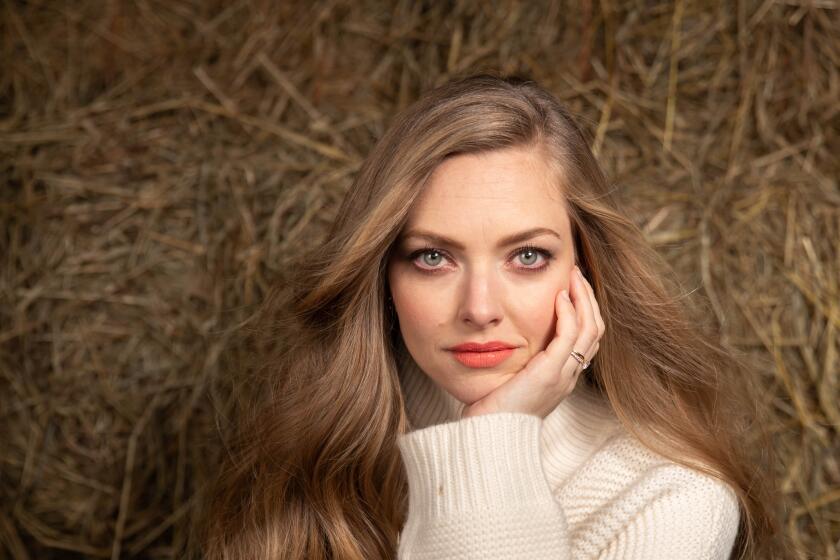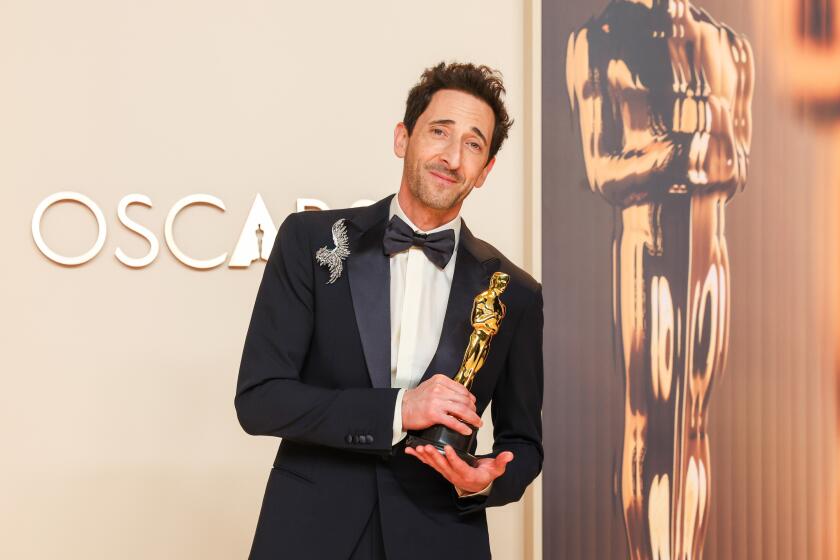Losing color opens a whole new world to ‘Mank’ cinematographer
- Share via
A couple of years ago, David Fincher’s go-to director of photography, Erik Messerschmidt, described the muted palette of the TV series “Mindhunter” as a product, in part, of the pair’s shared “aversion for magenta.” Color palette proved to be a nonissue during the making of “Mank,” since the movie depicts “Citizen Kane” writer and Hollywood bad boy Herman J. Mankiewicz (Gary Oldman) and his coterie in period-correct black and white. Speaking from Georgia, where he’s prepping the Korean War movie “Devotion,” Messerschmidt half-joked, “The great luxury of black and white is that any nausea [over color] that we might otherwise be dealing with, we didn’t have to worry about for ‘Mank.’”
Previous to filming “Mank,” Messerschmidt, who met Fincher seven years ago while working as a gaffer on “Gone Girl,” had barely shot anything in black and white. “I’d dabbled in still photography as a hobby and shot a couple of very simple music videos, but no features,” he says. “When David called me to do ‘Mank,’ black and white was a foregone conclusion.”
Fincher says he insisted on monochrome imagery for “Mank” because it best served the story scripted by his late father, Jack. “I had always been of the mind that you bury your exposition, but my dad was a huge fan of movies from that period,” Fincher recalls. “He told me, ‘Dave, people in those movies just did it. They talked in an expository manner.” So ‘Mank’ has this anachronistic quality in the way information is doled out. A guy walks in and says, ‘This is Rita Alexander, she types 100 perfect words a minute, takes dictation like a clairvoyant.’ You need a visual context for that to work. And to my way of thinking, there’s no faster way to transport you to the 1930s than black and white.”
To immerse himself in Hollywood’s pre-color era, Messerschmidt, of course, studied “Citizen Kane,” shot by Oscar-winning cinematographer Gregg Toland. He also watched “Casablanca” and the Hitchcock thriller “Rebecca” along with mid-century noir classics such as “The Big Combo” and “Night of the Hunter.” “I felt myself being almost seduced by the idea of shooting in this very stylized noir way,” Messerschmidt says. “But David and I concluded that noir wouldn’t be the right look for ‘Mank,’ because it’s not a gumshoe story. It’s not Philip Marlowe. The idea was to pay homage to Gregg Toland by taking cues from his approach, but we also included some modern elements.”
Known for movies about crime and chaos, director David Fincher delivers a personal tale with “Mank.”
One modern element: the digital camera. After extensive testing, the filmmakers decided to use the Red Helium Monochrome to film the actors at 8K resolution. “The gradations are so crisp and have so much tonal depth,” Messerschmidt says. “Color cameras didn’t have the same sensitivity to light. And our cameras have very fast f-stops, which allowed us to achieve the deep focus that’s a very specific hallmark of “Citizen Kane.”
Playing early Hollywood actress Marion Davies and working with David Fincher in ‘Mank’ was a ‘dream,’ says Amanda Seyfried.
One of “Mank’s” most striking sequences, set at Hearst Castle’s private zoo in San Simeon, features the old-school “day for night” trick to show Mank and Amanda Seyfried’s Marion Davies taking a moonlit stroll past monkeys, giraffes and elephants. In reality, the scene was staged in broad daylight at the Huntington Library in Pasadena and a nearby mansion, with computer-generated creatures added after the fact. “We wanted the audience to appreciate the scope and scale of San Simeon, but if we’d tried to light that scene at night, it would have required tremendous amounts of heavy gear and cranes and lighting equipment,” Messerschmidt says.
To pull off the midnight-at-noon illusion, Messerschmidt severely limited the amount of sunlight hitting the camera’s image sensor. The problem: “Because I’m underexposing the image, the actors’ faces get quite dark, so you need to shine really bright lights on Gary and Amanda’s faces. But you don’t want them squinting the whole time.” The solution? “We outfitted the actors with sunglass-tinted contact lenses.”
Bristling with sardonic banter, “Mank” peaks dramatically when Oldman as Mank shows up drunk on New Year’s Eve at Hearst Castle, orbits around the guests gathered around an enormous dining room table, insults his bosses and vomits. Messerschmidt notes, “The coverage is quite complex, because we needed reaction shots between Marion and Mank, Marion and Charles [Charles Dance, as Hearst] looking at Mank. There’s all these looks.”
For the benefit of multiple camera angles, Oldman had to hit precise marks and repeat his tirade many times over the course of several days. “First, we’re leading Gary with the camera, then we’re following him, then we’re on the other side of the table tracking, then Hearst’s POV, but that only works for certain pieces of the table, because the shot’s blocked by extras,” Messerschmidt recalls.
“In terms of professionalism, Gary was spectacular even when he was off-camera. For Marion’s close-up, all we see is Gary walking behind her for a moment, but she and the other actors had the real Gary Oldman to react to. Time after time, he gave that performance, and by the end, I think the entire crew knew every line of dialogue by heart.”
More to Read
From the Oscars to the Emmys.
Get the Envelope newsletter for exclusive awards season coverage, behind-the-scenes stories from the Envelope podcast and columnist Glenn Whipp’s must-read analysis.
You may occasionally receive promotional content from the Los Angeles Times.








